The thing you can never account for when you are sitting at home planning your Round The World trip is the novelty factor of attractions. Or to be more precise, how quickly that novelty factor will wear off once you’re actually off the couch and out in the world. When you’re stuck in a cubicle and in front of your computer and your window into the world is comprised largely of travel blogs and guidebooks, EVERYTHING sounds fascinating and breathtaking and utterly unique. You star every cave and mountain pilgrimage, and highlight every set of ruins and temples in every city you plan to visit; your dreams are as big as the world itself and all you have stretching out in front of you is endless reserves of time.
When you’re stuck in a cubicle and in front of your computer and your window into the world is comprised largely of travel blogs and guidebooks, EVERYTHING sounds fascinating and breathtaking and utterly unique.
Of course, once you actually start traveling, it doesn’t take you very long to discover that in fact, you are not in possession of infinite time, and even without work obligations and all the trappings of your former lifestyle, you simply can’t see everything everywhere you go.
What’s more, you soon won’t want to. Not only is traveling full-time pretty exhausting, but the reality is simply that the novelty factor of all the things that seemed so foreign and cool to you back home in Nashville or Swindon (or wherever it is whence you escaped) wears off faster than you might think. I’m not saying that you find yourself weary of the world or utterly inured to the charms around you, it’s simply that at first, any Baroque-era church is going to astound you by virtue of the fact that you’ve never seen anything like it, but after a several days, weeks, or months of seeing these things day in and day out, well, they are no longer so unusual nor as awe-inspiring as they initially were.
The common parlance for this condition amongst travelers, whether it refers to waterfalls or Renaissance sculptures, is generally “temple fatigue”, though you can also use it as a verb, as in: “After two months of traveling through Japan, Hong Kong, and China, I was templed out.” Seriously, although I know we saw some pretty incredible things while we were in all of those countries and I am generalizing more than a little when I lump Japanese & Chinese temples together, I am sticking to my story that I was pretty sick of Chinese-style temples by the end of our time there. Chances are that unless you have a super obscure university minor in them, then you probably will feel the same at some point during a trip to Asia.
So what’s a temple dilettante to do? Well, giving yourself some time away from whatever you’ve been ODing on will certainly help. In my case, two months in the Philippines where we saw a lot of beaches and even more Catholic churches, but nary a temple, was just what I needed. I think that what the poets say about absence making the heart grow fonder is true, and when we touched down in Taipei and the scenery and our surroundings transformed as dramatically as though we had actually landed upon another planet, my enthusiasm for temples, pagodas and monasteries was renewed and I felt ready to seek out and feast my eyes on the very best ones the city had to offer.
Of course, if I had run around determined to see every single temple based in Taipei, I likely would have burned myself out within 24 hours and needed another two months to recover. Because I may like a pretty temple as much as the next person (and—as you will see—Taiwanese temples are very pretty indeed), but I probably do not like them MORE than the next person, which is to say that when it comes to temples and me, absence may make the heart grow fonder, but I can also very much get too much of a good thing.
So, while in Taipei, we didn’t try to see every single temple. Instead, we did our research and then strategically visited the ones that seemed the most interesting, important, unique, or some combination thereof, and I suggest you do the same. And if research doesn’t get you out of bed in the morning like it does me, you can pretty much use this post as your guide of what we believe to be Taipei’s top three temples. I mean, even if you’re templed out, you can handle three temples, right?
The Famous One: Longshan Temple
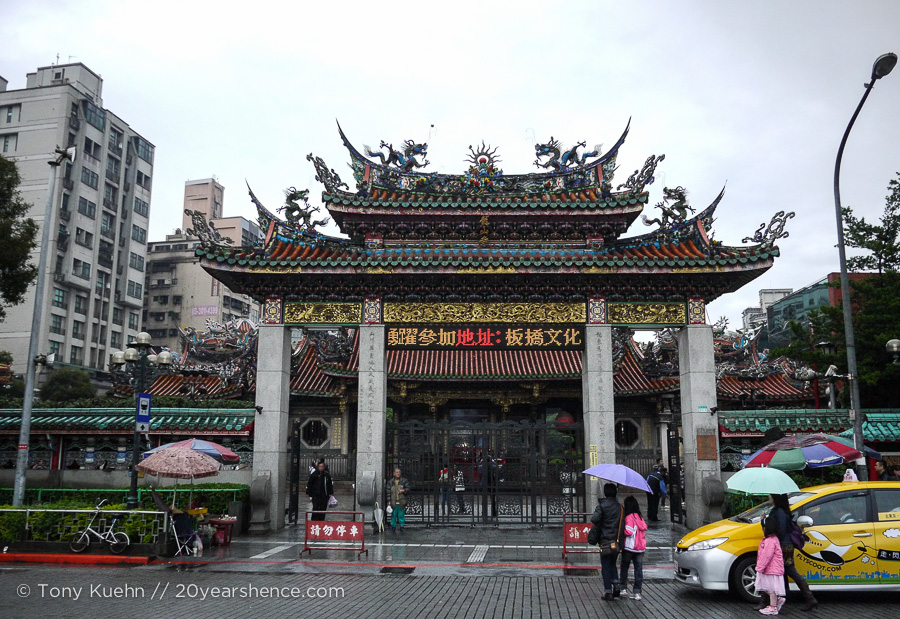
If Longshan Temple is not Taipei’s most famous temple, then I would hazard to say that it is still probably its most iconic. It was built in 1738 and is dedicated to Guanyin, the goddess of mercy, but what you really need to know is that it’s utterly gorgeous.
We visited during a break in one of the many rainstorms that would besiege Taipei during our time in the city, which could have made for a rather bleak atmosphere, but if anything, the rain only added to our visit; it made the stones paving the temple grounds gleam, and helped muffle the sounds of traffic and busy city life that echoed outside the temple walls so that upon passing through Longshan’s gate, a thick hush filled the air.



One interesting element to Longshan is the beautiful waterfall that sits in the courtyard just outside the temple proper, which some think may be a tribute to the immigrants from Fujian, Chian who crossed the treacherous waters to reach Taiwan. Indeed, the very stones that shone so brightly from the rain come from the ships that brought these travelers to Taiwan’s shores, and in addition to Guanyin, the goddess of safe sea and land travel, Matsu, is also honored here.

As for the temple itself, we were completely unprepared for the explosion of color that greeted us inside. We thought we had seen the epitome of impeccably preserved and ostentatiously decorated Chinese-style temples at Nikko in Japan, but Longshan took things to new dazzling heights. The temple was perfectly restored (despite having been bombed and damaged during WWII), and covered in carvings and decorations so lavish, they nearly made our eyes cross as we tried to take them all in. The gloomy gray skies above only served to heighten the vibrancy of the colors and glittering gold details that seemed to burst from every crack and crevice, a true chromatic free-for-all.
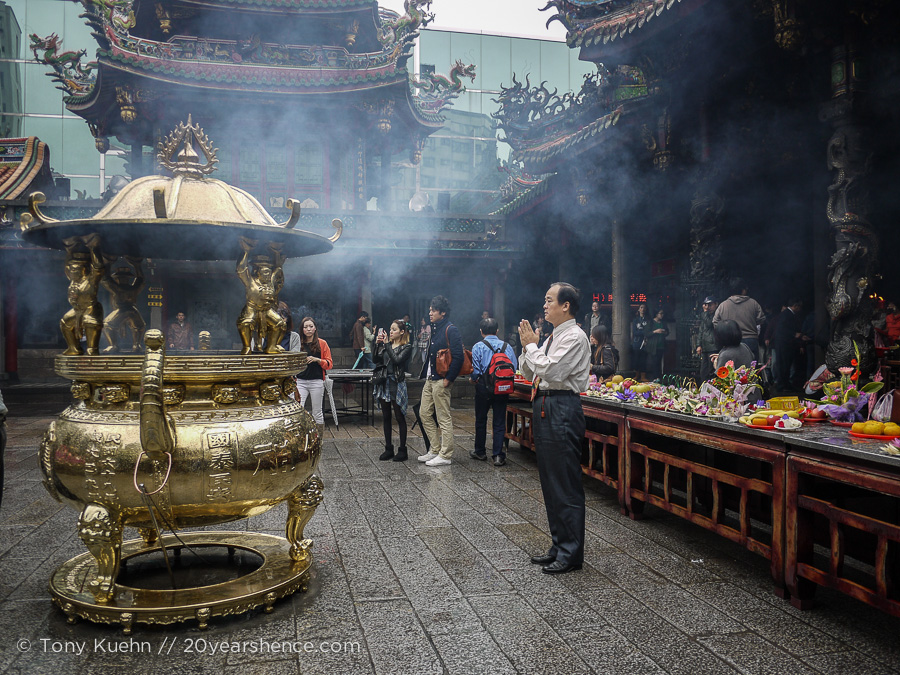


Perhaps the most impressive thing about Longshan is that despite its pristine appearance, the temple is not untouched but is instead a living religious structure. The temple has a calm atmosphere, but we were constantly bobbing through crowds of people who came to pray and make offerings. It was fascinating to have the chance to stand on the sidelines and simply observe the activities of the temple unfold, trying our best to make sense of the many mystifying rituals that take place there. Best of all for tourists and the photographers amongst us is the air of inclusiveness that seems to pervade the place—not once were we made to feel unwanted or as though our presence was an intrusion, and no one seemed at all put out that we were there to marvel at the temple’s beauty and (respectfully) witness their worship. You can snap photos to your heart’s content without worrying about catching any flack for it.
Off The Tourist Track: Qingshan Temple
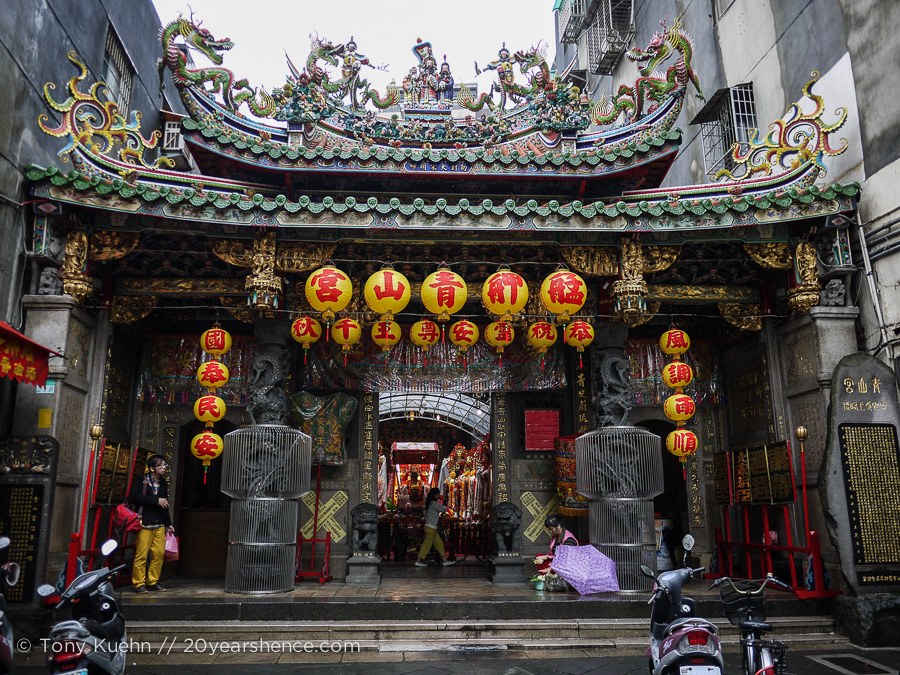
Less than a kilometer away from Longshan Temple, Qingshan is a much smaller and more intimate temple. It’s couched in a strip of skinny non-descript buildings, that do little to entice a random passerby to take a detour, meaning Qingshan is all too easy to miss.
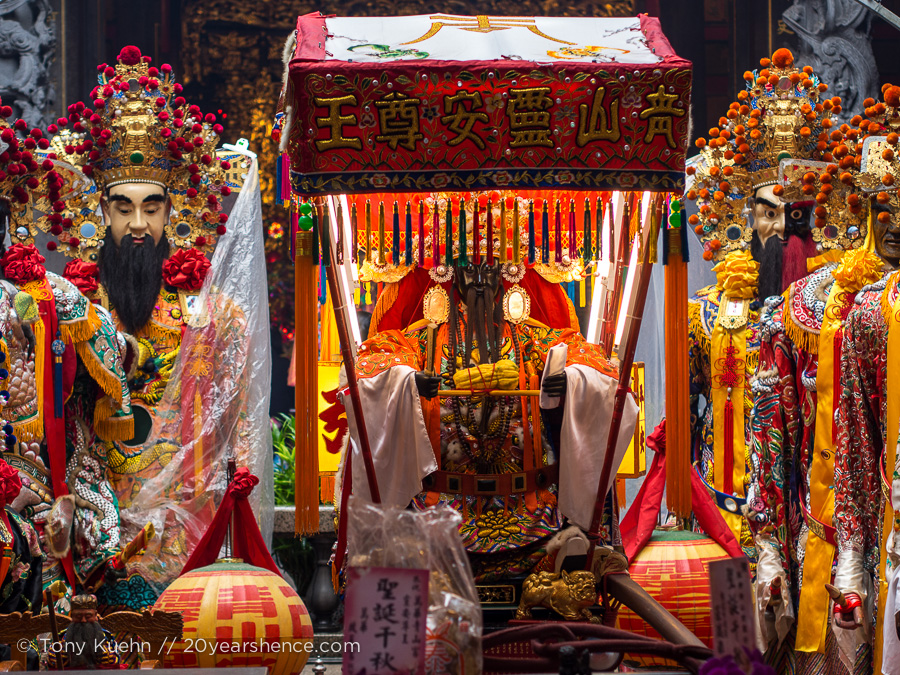
Once inside, however, it’s hard to believe that such a quiet little street houses such an animated little temple. Unlike Longshan temple which has rather expansive grounds, Qingshan spans multiple floors and is deeper and taller than it is wide. As you penetrate the main entrance hall, massive deities dressed in elaborate finery tower above and watch over you as you make your way through the atrium up to the central shrine at the back of the building. Because the temple is narrow, it has a somewhat cluttered, claustrophobic air to it with every corner, every surface, containing some sacred relic or offering.
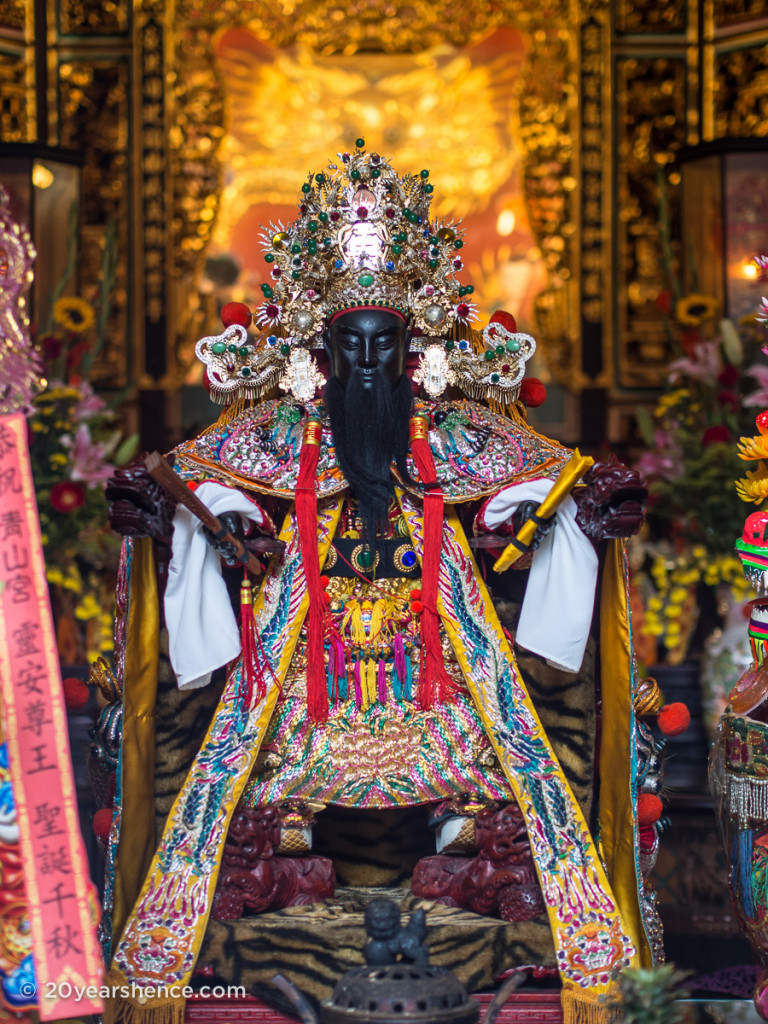

Although Longshan is very much an active temple, there is an aspect to it that seems a bit like one is observing an elaborate production of performance art, or at the very least, like it is a temple many Taiwanese people reserve for special occasions. On the other hand, Qingshan seems more like an every day, working temple, one that people might pop into on their way home from work or while out running errands. It doesn’t necessarily have the grandeur of Longshan (though it clearly has more than its fair share of “bling”, as you can see), but we liked that it still had a steady stream of visitors and offered us a peek into the quieter, less dramatic side to Taiwanese temple worship. We got the sense that this wasn’t really one of those temples that sees many foreign visitors, and while we wouldn’t say there is really anything about it that was understated or banal, its scale is not as grand as Longshan.

Still, one thing that Qingshan offers that Longshan does not is a really fantastic view of the city from its upper floor. Staring out at the many contemporary skyscrapers made of glass & concrete across the backs of rainbow-hued dragons and the intricately tiled roof of the temple, you get to enjoy a visual representation of the interesting juxtaposition of Taipei of the 21st century: a modern urban metropolis rooted with a deep history and rich religious tradition that persists and colors the city even today. With so many buildings clustered around it—so close you feel that with enough courage your could reach out and brush their walls with the tips of your fingers—the co-mingling of the country’s past & present has never seemed so salient.
Our Personal Favorite: Bao’an Temple
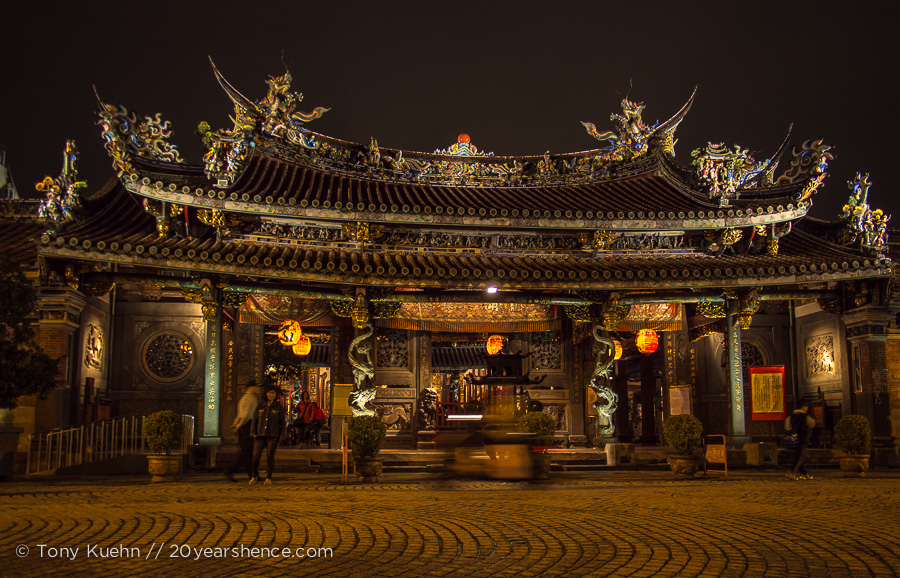
Longshan & Qingshan are both nice, but if you only have time or inclination for one temple in Taipei, make it Bao’an. The truth is, we nearly missed out on this gem entirely as we had headed to the area with the intention of visiting Taipei’s legendary Confucius temple. Alas, it was a Monday, the one day the temple is closed, so we were out of luck and thought we would have to content ourselves with watching a fat little squirrel dance upon the walls of the grounds.
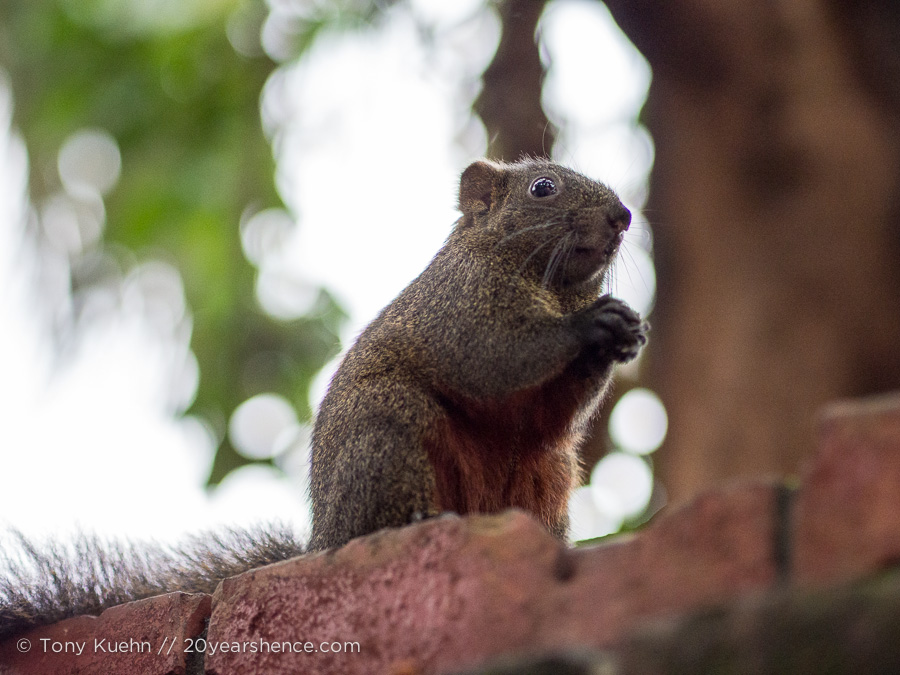
A quick look at our map showed us there was another just a few blocks away, so we slowly made our way in that direction, disappointment heavy on our shoulders. Bao’an was meant to be a consolation prize, yet, hands down, it wound up being our absolute favorite temple in Taipei. To say it is arresting is but to scratch the surface of Bao’an—when we first caught sight of it, Tony & I both stopped in our tracks and let out a long, slow exhalation in tandem. Quite literally, Bao’an is breathtakingly beautiful.
It’s hard to pinpoint what about Bao’an sets it apart from Longshan, as the two have similar styles, as they were constructed around the same time, and reductively, one could say that they’re both wooden temples that are positively dripping in elaborate carvings and color. Maybe it’s because we hit it at exactly the right time, late afternoon, when the sun was burning low in the sky suffusing every surface with burnished warmth.
We wandered around mesmerized for hours, lingering long after the sun had set. As the sky darkened, the temple saw new life as the lanterns throughout it were lit, their sumptuous glow irresistible. The temple was so impossibly lavish and there was such a pervasive sense of peace here that it’s hard to think that the Confucius Temple could have been any better. If I had to describe Bao’an with one word, it would simply be magical.
Bonus: Right across the street from Bao’an temple is a cute, quirky statue park that is worth a quick visit!
In some ways, the temples in Taipei are themselves an antidote to any temple fatigue you might find yourself experiencing. Every single one we visited was beautiful beyond belief, so vital, and provided us with such insight into Taiwan and deepened our appreciation for the local culture. Truly no matter your state of mind when you visit Taipei, any one of these three should prove a temptation you don’t even bother trying to resist.
Tell us: have you ever been to Taipei? If so, which temple was your favorite? If not, which of these three would you make sure to visit?
I know what you mean about fatigue. After six months in Europe, I was pretty much done with cathedrals. As a Catholic, I also found most of the decoration a little gaudy for me. It’s neat at first and I like to hear the history of the structure, but eventually it does lose its charm. Those temples are pretty cool, though. I’d probably visit that last one. It looks kind of mysterious.
Ha! If you think European temples are gaudy, I can’t wait until you make it to Asia and see some of what they’ve got going on here! I think so far I would say Taiwan and Thailand take the cake when it comes to over-the-top bling!
I love this post so much. I remember having ODd on triptychs in Italy. Enough!
But I must say, there is something indeed magical about these temples, especially the first two that are tucked away in the middle of these other buildings. So surprising.
All three look incredible, but I’m glad the last was so breathtaking. I cannot imagine seeing these in real life. They’re so spectacular and colorful. So different from anything I’ve ever seen. I’m so glad you highlighted them here.
We thought we knew what Chinese temples were like given that we had already spent a month in China proper prior to visiting to Taiwan, but the temples in Taiwan definitely blew the mainland’s offerings out of the water. I don’t think I’ve ever seen such intricate and pristine temples anywhere, and what made it all the more crazy was the fact that every single temple we visited was active and clearly in use!
I remember when I was in France for six weeks, all the things that astonished me in the beginning became almost commonplace by the end, and I remember feeling very sad about that. I suppose that’s just natural – as you’re in a place for a long time, you become used to some things, and you stop seeing them the way you did before. I love that everything was new again once you came back! All three of those temples are amazing.
Amanda! So great to hear from you again after your many month hiatus! 😀 Very happy to have you back!
I think you hit the nail on the head, as the more I travel, the more I realize that we have this innate capacity to adapt and adjust to our surroundings; if we stick with something long enough, eventually the things that initially seemed so foreign and mindblowing ultimately just become part of your life. It’s human nature to adapt to things in the environment that don’t change, and sadly, I suppose things we initially find beautiful can suffer from this as well!
Great shots! Most of the temples in China have been destroyed and rebuilt, making the a lot less atmospheric.
Yup, I completely agree. We were really disappointed by most of the temples we saw while in China as they were so rundown, derelict, or destroyed. But the ones in Taiwan, they took our breath away. I kind of believe that if you really want to experience the lovely bits of China’s culture and history, you need to go to Taiwan!
Ah temple fatigue, I know thee so well!!! That is exactly why we followed your plan in Angkor Wat 🙂 These all look beautiful but Bao’an is stunning, the carving detail is pretty incredible.
I find the longer I travel, the quicker fatigue is to set in for pretty much everything we go to see! I just don’t have it in me to do day after day of sightseeing as everything starts to blend together and see so “samey”, so it’s nice to give yourself and the sights room to breath so you give yourself the best possible chance to appreciate them!
I think you mistook the Qingshui Temple for Qingshan Temple. They are both close to each other, but Qingshui is much bigger than Qingshan (the one you have visited).
Here’s Qingshui Temple as I introduced it on my blog: http://mykafkeasquelife.blogspot.com/2013/02/chingshui-temple-wanhua-taipei.html
The names also sound very similar: 清水 (clear water) and 青山 (green mountain). I actually mistook these two temples, too, when I walked around Wanhua for the first time 🙂
Greetings from New Taipei.
Thanks for the heads up and for the interesting bit of trivia on the two different meaning of the temple names! I think you are right & that we must have visited Qingshan temple, not Qingshui temple as we previously thought! I’ve changed the article to reflect this.
Bao’an is definitely worth a visit… or two or three. I also was looking for something else in the area – the park across the street – and stumbled across the great temple. I have gone back several nights now just to sit, enjoy the aroma, and take in the scenery. It’s fantastic. And the squirrels in Taipei do seem to be rather fat.
I’m sure we’ll be back to Taipei at some point (we love Taiwan too much to stay away) and when we return, I’ve no doubt we’ll head back to Bao’an for a follow-up visit. I envy your ability to go back and enjoy it whenever you please!
Thanks for this post. Because of it, I spent tonight at Bao’an. Also got to see the Confucius Temple, so that was a plus. But you’re right – Bao’an is special. And although the temple(s) here are spectacular, what I will forever remember are the worshipers.
I’m so glad to hear that you found this post helpful and were able to enjoy the splendors of Bao’an temple. Despite seeing hundreds of temples all over Asia, I still think it is one of my favorites; definitely special. And you are right, the worshipers definitely add to the entire experience.
I just got back from Taipei and wish I found this earlier! We loved the Longshan temple and I’m sure would have enjoyed Bao’an too! Love your photos by the way 🙂
So glad to hear you enjoyed your trip to Taipei, Mike. Bao’an was definitely our favorite temple, but in Taiwan, you can’t really go wrong. 🙂
Was there an entrance fee to the statue garden that was across the street from Bao’an temple? I am going to Taipei in December. Is there any other “must see” place or things to do that I should consider? Thanks!
Hi David! I don’t believe that there was any kind of entrance fee for any of the temples we visited throughout all of Taiwan.
Taiwan is a marvelous country so no matter what you choose to see and do, we are confident you will have an excellent time. We fully admit that for us, most “must see” attractions revolve around food… In Taipei, you should absolutely make sure you hit up some night markets (they’re the best place to eat in the evening… and we did write a post about our favorites so you can check that out). You can also do some fun day trips from the city too—we enjoyed heading out to Beitou to soak in the hotsprings. Should be nice in December!
Thanks Stephanie… Yes. I plan on going to Beitou and Shifen as well. Food is important to me as well. Any particular restaurants standout in Beitou or Ximending (somewhere else?) Thanks!
I think we just grazed while in Beitou (maybe picking up some snacks from a convenience/grocery store) & saved our more serious eating activities for when back in Taipei. Normally we’d have smaller meals throughout the day so as to save stomach space for the night markets! 😀
Fantastic photos, really beautiful. Yes, I like your 3 choices. I lived in Taipei for 11 years and must have visited nearly every Matsu temple on the island and some offshore ones. In Taipei, the Bao An temple is a big favourite, along with that little park you mentioned, near Ha Mi street. Another good place to visit is the Chi Nan Temple , just up the mountain from Mucha in WenShan district. There’s a bus that goes up there, used to be the number 1, from the Chi Nan bus co. I wonder if it is still running. There are some beautiful grounds to wander around in and you can sit down on stone benches. You might see the occasional little snake though so don’t stray too far off the path. The temple is very atmospheric and on certain days, you can hear the monks chanting. The third one I would choose is the Xin Tian Temple which now has its own MRT station. There are ladies in blue smocks who will give you a blessing. You just need to queue up, tell them your name and stand with your hands at your did, bags on the floor. They use incense sticks and walk around you, repeating some words to make you feel safe and calm. It’s good if you’ve had any kind of shock or upset. Remember to say ‘xie xie’ afterwards. I love Taipei, it’s a very special place.